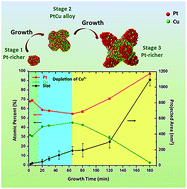Revealing the elemental-specific growth dynamics of Pt–Cu multipods by scanning transmission electron microscopy and chemical mapping†
Abstract
In this work, we reported our experimental approach to reveal the detailed growth behavior of platinum (Pt)–copper (Cu) bimetallic multipod nanostructures in a one-pot synthesis by analyzing the intermediate products from different stages by using aberration-corrected scanning transmission electron microscopy and associated energy-dispersive X-ray spectroscopy. An element-specific growth trajectory of Pt–Cu multipod nanostructures with compositional variation couples to geometric morphologies was observed: Ptx–Cu1−x multipods start from Pt-rich seeds (x > 0.6), evolve into a Pt–Cu alloy phase (x ≈ 0.5), and then form Pt-rich branches (with x > 0.8). This could be further explained on considering the different redox potentials of two metals and their interactions through underpotential deposition, galvanic replacement, and phase segregation. The observed combination of geometric morphologies and compositional variations may provide new strategies to potentially aid rational synthesis of alloy catalysts.


 Please wait while we load your content...
Please wait while we load your content...